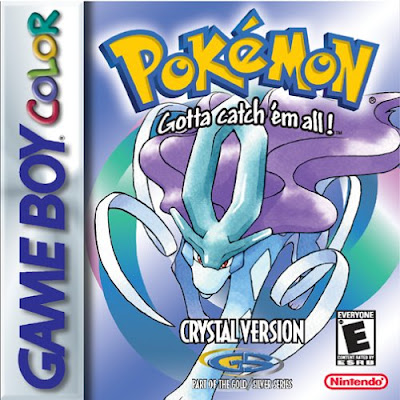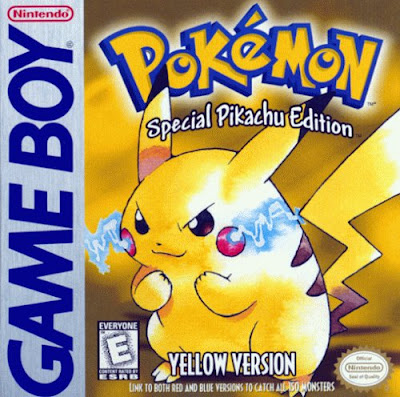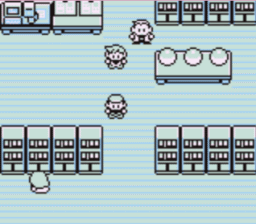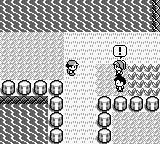 |
| Pokemon Gold/Silver Versions |
The Short
Pros- Adds 100 new pokemon to the mix, and an entire new region to explore
- Adds a day/night cycle that advances in real time, and changes which pokemon are available
- You can now breed pokemon. The implications of this are
nuts.
- Can re-visit the entire region from the first game, three years later, and battle all the same gym leaders
- Ability to map items (such as the bicycle) to a button greatly speed up the game
- Two new elements, Dark and Steel, further mix up this elemental-based battler
- Finally adds an XP bar to the battle screen. HALLELUJAH.
- Pokemon now have individual "happiness," which can change how they evolve, react, etc.
- Split Special into Special Attack and Special Defense, which changes a lot of things up
- Improved graphics and the best soundtrack in the series
- Probably had the most significant changes out of any
Pokemon generation
Cons- Still has several of the same core gameplay niggles as the previous games
- Pokemon no longer follow you around like in
Yellow- Batteries on these karts usually only last 7 years, meaning if you get one now your odds of being able to save aren't great
- I can't think of anything else. This really might be a perfect game.
 |
| Back to Pokeland. And yes, Silver is the better version, you Gold tards. |
Note: I will not be going over the basic mechanics of the Pokemon
games in this review, as I have covered these mechanics extensively in my Pokemon Blue/Red review. Instead, all subsequent reviews will instead focus on the changes made to the formula in any particular iteration. The Long
Pokemon Gold/Silver is my favorite Pokemon generation. It's the generation where I really started to get into the games, the obsession of "catching them all" hitting full force. I sunk hours and hours into this game on my quest to become a Pokemon Master, and I can honestly say I'd do it again (if I still had a cartridge). Pokemon Silver is nostalgia city for me, so bear with me as I try to not gush too much about how much I freaking love this game.
Pokemon Gold/Silver is technically the second "generation" of Pokemon games (Pokemon Yellow doesn't count because it was a spinoff of Blue/Red), and Nintendo knew they needed to up the ante. Pokemon was a massive phenomenon by this point, so something had to be done to keep fans intrigued while still keeping things relatively familiar. So what they did was essentially genius: added a ton of new stuff, all of which could both be either really simple or extremely complex based on how seriously you took it. It grabbed that idea from Pokemon Red/Blue that these games could be played by both kids and more serious gamers and blew it out of control. Seriously, pokemon breeding was just...well, I'll tell you.
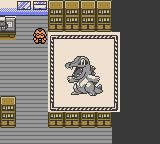 |
| Totodile. The greatest starter ever. |
First off they revamped the entire adventure. Unlike Yellow, which was the same as Red/Blue but with Pikachu, Gold/Silver was a new quest set in a different land of Johto rather than the Kanto from the first games. It starts out relatively similar, with you being tasked to go off on an adventure to "Catch 'Em All!" for a Pokemon Professor, and he lets you pick from a set of three Pokemon of the fire, water, and grass variety (Cyndaquil, Totodile, or Chikorita). You again have a rival, though this time he's more like a punk red-headed thief rather than the professor's grandson.
 |
| As a red-head, I'm offended. |
The adventure plays out pretty much exactly the same. You still have eight Gym leaders to beat up before taking on the Elite Four and finally the Champion, finally proving yourself as the Pokemon king. The crazy part is that after you beat the Champion (which is no easy thing; Drake's a powerhouse) the game actually lets you go back to Kanto from the first game and replay all their Gym leaders, a few of which have been replaced and all their pokemon buffed. You can then re-fight the Elite Four and Champion, who have also upgraded their pokemon, and even go battle Red, your main character from the Red/Blue games. Protip: He's a badass.
 |
| Kid's game? The battle with Red is nuts. |
So you are essentially getting two games for the price of one here, which is awesome. But enough about that; that are the real changes? What is different between this and Red/Blue/Yellow that makes it worth your time?
Well, the first big thing is the Day/Night cycle. Now when you load up the game it asks for the current time, and the game will adjust accordingly. As you travel, as it becomes night in the real world, it'll become night in the game. The crazy part is that some Pokemon only come out at night, and many pokemon have different encounter rates based on whether you are hunting them in morning, evening, afternoon, night, etc. It also knows what day of the week it is, with certain events happening only on certain days. As you battle across the land you'll also add people to your phone book (another new feature), and sometimes trainers you've defeated will call you on certain days for a rematch.
Like having Pikachu following you around in Yellow, this adds a ton of immersion points for me. Yeah, nothing anybody says when they call is particularly interesting (though I thought my mom calling me was funny) and usually it's either straight business or total uselessness (I don't care that you just failed at catching a Caterpie! I have like ten of those already!) but it's still a good touch. The Day/Night thing is also totally awesome, because then I had to plan when I was playing the game. If I wanted a Hoothoot (an Owl pokemon, obviously) I'd have to stay up later and run though the forest at night to grab one. It was a really cool feature and helped make the game feel more "real."
 |
| I'm coming for ya, you stupid Hoothoot! |
To compliment this new spin on pokemon hunting, they added 100 new pokemon, and two new elemental types: Dark and Steel. Dark and Steel were made for two balancing purposes: to make Psychic less totally invincible, and make Fighting actually useful. They also readjusted elemental weaknesses and strengths from the original fourteen, and it's been the same in every game ever since. The new pokemon were just as well designed as the first 150, if not more so. The 100 in this game are probably my favorites in the series in terms of design and just general awesomeness. As a bonus you could still catch all of the 150 from the first games, assuming you had both versions (
Gold and
Silver).
 |
| Adding these new elements bumped up the complexity even more. This is a lot to memorize! |
Strategy in battles was also mixed up. Pokemon could now hold items, such as berries, that they would auto-use in times of danger without costing them a turn. They were all essentially single use if they were consumables, while items like the Exp Share, which helps with leveling up lower-level pokemon, weren't. You could give them items that powered up specific moves, but then you'd have to decide if that was better than having a healing item equipped. It added a ton of strategy, though it also mostly just made me pissed off when I thought I was about to win and my stupid opponent heals half his health back with a berry.
But all these pale in comparison to what is probably the deepest addition to the game, and the one that makes some people go totally nuts about Pokemon: the new breeding system.
 |
| Don't fall asleep, I'll be quick. |
I'm going to be brief. On the surface level this meant you could produce more pokemon, simple enough. The perk was that you could essentially get more of the rare ones (such as your starters) by breeding them and then hatching the produced egg (and since Dittos can breed with anything they suddenly became one of the most prized pokemon in the game). Legendaries couldn't breed, but since every pokemon had a gender if you got one of each (or one and a Ditto) you could finally replicate those rare pokemon.
And that isn't even the half of it.
Pokemon inherit moves and stats based on who their parents are. If you just breed with a Ditto you don't get anything interesting, but many pokemon will breed with different pokemon than themselves, meaning you can mix element types. In a game that so heavily focuses on elemental moves, having an electric type that knows a water move can be game-changing. This is all stupidly complicated and I never got too deep into it, but just know that it's there, and it's nuts.
 |
| Penny Arcade knows. |
Lots of little changes also make the game better. You finally have an XP bar that fills on the right for each pokemon after each battle, so you can follow as they level (yay!). You can map items to a button (like the bicycle) for instant use rather than having to dig through a menu to get to them. Menus are very similar to Red/Blue but seem to be streamlined in ways I can't put my finger on. It's all running in the same engine but looks cleaner overall, which is appreciated.
 |
| Battle backdrops are still just white, but the Pokemon themselves look real good |
Pokemon Gold/Silver was the first
Pokemon game designed for a color system, and boy...they did a really good job. The first thing you get when you boot the game up is a full-color intro sequence that was totally awesome. In-game the graphics are excellent for a Game Boy Color game, with areas being vibrant and using the limited color pallet of the GBC to a full extent. The stars of the show are certainly the Pokemon, which all look unique and well colored, though the lack of any background in battles is a bit of a downer (though I have no idea how they would have pulled it off). They do well with using the limited real estate space of the GBC screen to pack everything on while still looking good, so there you go.
The music of Gold/Silver is my favorite in the entire series. Yeah, some songs in later versions might be up there, but nearly every song in this game is great. Like the graphics, they do well with using very little to do a whole lot. The battle songs are especially great, but the songs for the towns and routes also shine.
Plus, the final boss song is nuts.
There's probably more that could be said about the changes in Pokemon Gold/Silver, but I think I've said enough already. The point is: if you like deep, turn-based JRPG battles and you haven't jumped on the Pokemon train, you are missing out in some of the best the business has to offer. Easy to pick up, almost impossible to master, Pokemon Gold/Silver was really where the series took off. I can't think of a better place to start (though the re-releases - SoulSilver and HeartGold on the DS - are very faithful representations with all the improvements that have been made since), and as it stands this is easily the best Game Boy Color game ever released.
If you have a GBA or GBC you are missing out if you don't have one of these games in your collection. Five out of five stars.





